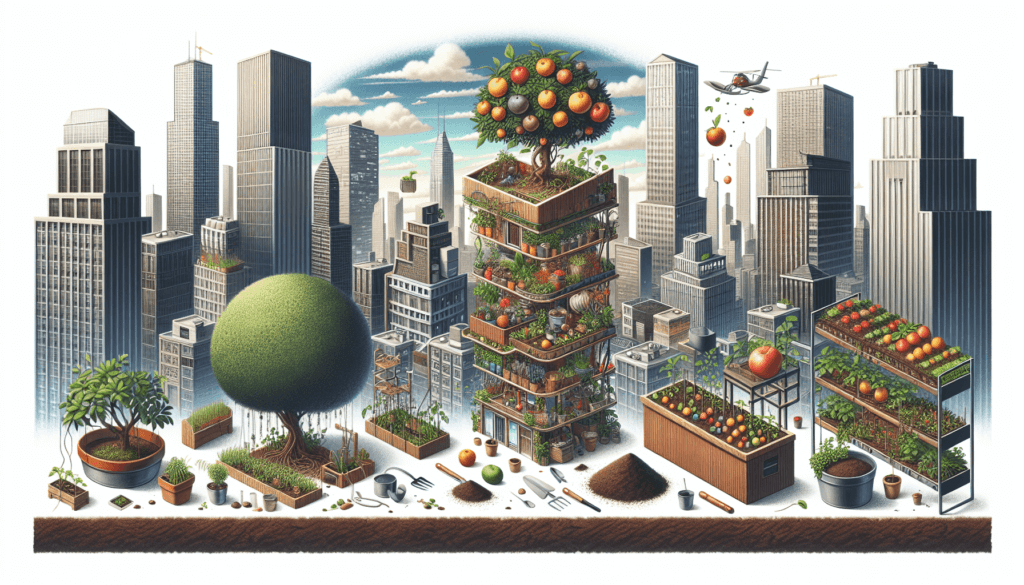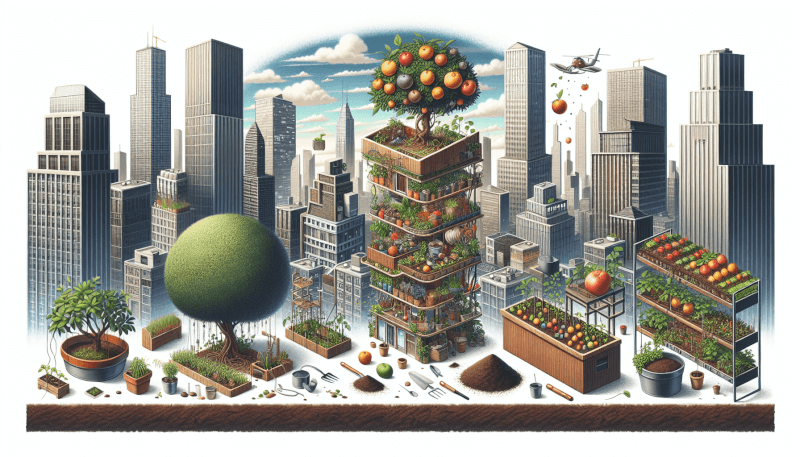Are you a city dweller yearning for the delicious taste of homegrown fruits? Look no further than this comprehensive guide on growing fruits in small urban spaces. Whether you have a tiny balcony, rooftop, or even just a windowsill, this article will provide you with all the tips and tricks you need to successfully cultivate a variety of fruits in your limited urban environment. From selecting the right plants to optimizing space and ensuring proper care, you’ll be well-equipped to enjoy the satisfaction of watching your very own fruits flourish right in the heart of the city. Get ready to embark on your urban fruit-growing adventure!

Choosing the Right Fruit
When it comes to growing fruits in small urban spaces, it’s important to choose the right fruit varieties that will thrive in your specific climate and available space. Consider the amount of sunlight your growing area receives and the size of the space you have available. Some fruit trees require full sun, while others can tolerate partial shade. Do your research and find fruit varieties that are well-suited to small spaces, such as compact or dwarf varieties. Additionally, consider your personal preference for fruits. What fruits do you enjoy eating the most? By choosing fruits that you love, you’ll be more motivated to care for and maintain your fruit plants.
Preparing the Growing Area
Before you start planting your fruit trees, it’s important to prepare the growing area properly. Assess the amount of sunlight that falls on the area throughout the day. Most fruit trees require at least 6 to 8 hours of direct sunlight to thrive. If your chosen space doesn’t receive enough sunlight, it may be necessary to reconsider the location or choose fruit trees that can tolerate more shade.
Another crucial step in preparing the growing area is checking the quality of the soil and its drainage capabilities. Fruit trees generally prefer well-draining soil to prevent waterlogged roots. Conduct a soil test to determine its pH level and nutrient content. If needed, amend the soil with organic matter to improve its texture and fertility. Additionally, ensure that the area is clear of weeds and debris. Weeds can compete with your fruit trees for nutrients and water, so removing them before planting is vital.
Container Gardening
If you have limited space, container gardening can be an excellent option for growing fruits. It allows you to cultivate fruit trees in pots or containers, making it possible to grow them even on balconies or small patios. When selecting containers for your fruit trees, choose ones that are large enough to accommodate their root systems. A general rule of thumb is to choose a container that is at least 2 to 3 times larger than the size of the root ball. This will provide enough room for the roots to grow and spread.
Proper drainage is essential for container gardening. Ensure that each container has sufficient holes at the bottom to allow excess water to drain out. If the container lacks drainage holes, the plant’s roots can become waterlogged and susceptible to rot. Additionally, use high-quality potting soil specifically formulated for containers. This type of soil promotes good drainage and is enriched with essential nutrients that your fruit trees need to thrive.
Espalier Training
Espalier training is an ancient horticultural technique that involves training fruit trees to grow in a flat, two-dimensional shape against a wall, fence, or trellis. This technique is particularly useful for small spaces as it allows you to maximize your fruit production in a limited area. Before you embark on espalier training, it’s essential to understand the concept and learn about the different espalier techniques available.
When choosing fruit trees for espalier, opt for varieties that have flexible branches and can tolerate the pruning necessary for shaping. Apples, pears, peaches, and cherries are commonly used for espalier due to their adaptability and ability to produce fruit in a confined space. Take into consideration the size of the mature tree and choose varieties that fit well within the available space.
Mastering different espalier techniques such as cordon, fan, or Belgian fence will allow you to create stunning and productive fruit tree designs. Each technique has its own requirements in terms of spacing and pruning, so it’s important to research and choose the one that suits your space and aesthetic preferences.

Pruning and Training
Pruning is an essential practice for maintaining healthy and productive fruit trees. By mastering the basics of fruit tree pruning, you’ll be able to control the growth, improve air circulation, and maximize fruit production. Pruning also helps shape the tree and promotes compact growth, which is especially crucial for small urban spaces.
When pruning your fruit trees, remove any dead, damaged, or diseased branches. This will improve overall tree health by reducing the risk of pests and diseases. Additionally, thinning out crowded branches will allow more sunlight and airflow to reach the tree, promoting better fruit development.
In small spaces, it’s common to train fruit trees against trellises or stakes for support. This not only saves space but also helps maintain good fruit quality by preventing branches from touching the ground or other plants. Training your fruit trees also ensures that they grow in the desired shape and form, making it easier for you to care for and harvest the fruits.
Pollination
Proper pollination is crucial for fruit production. Some fruit trees are self-pollinating, meaning they can pollinate themselves and produce fruit without the need for other plants. Others are cross-pollinating, requiring the assistance of pollinators to transfer pollen between flowers. Understanding the pollination requirements of your chosen fruit trees is essential for a successful harvest.
To ensure proper pollination in small urban spaces, consider planting compatible varieties. Some fruits, like apples and pears, require a cross-pollinator of a different variety to produce abundant fruit. By planting compatible varieties close to each other, you increase the chances of successful pollination and a better fruit set.
Introducing beneficial pollinators, such as bees or butterflies, to the area can also enhance pollination rates. Create a pollinator-friendly garden by planting flowers that attract these beneficial insects. Providing a diverse range of nectar-rich flowers will not only benefit your fruit trees but also contribute to the overall ecosystem health in your small urban space.

Watering and Fertilizing
Establishing a proper watering routine is essential for the health and productivity of your fruit trees. Monitor the soil moisture regularly, and water when the top inch of soil feels dry. Avoid overwatering, as excessive moisture can lead to root rot and other fungal diseases. Implement irrigation methods such as drip irrigation or soaker hoses to ensure the water is delivered directly to the roots and not wasted through evaporation.
Fruit trees grown in containers have different watering needs compared to those planted directly in the ground. Containers can dry out more quickly, so check the soil moisture more frequently and adjust your watering schedule accordingly. Be mindful not to drown the roots with excessive water.
In terms of fertilizing, organic options are excellent choices for promoting healthy growth and fruit production. Use well-balanced organic fertilizers formulated specifically for fruit trees. Apply the fertilizer according to the recommended rates on the packaging, ensuring you don’t over-fertilize. Regularly feeding your fruit trees with organic fertilizers will provide them with the necessary nutrients they need to thrive.
Pest and Disease Management
Identifying common fruit pests and diseases is crucial for effective management. Keep an eye out for pests such as aphids, mealybugs, and fruit flies, as well as diseases like powdery mildew and brown rot. Regularly inspect your fruit trees for any signs of infestation or damage.
To implement preventive measures, promote overall plant health by providing your fruit trees with proper sunlight, soil fertility, and water. Healthy trees are less susceptible to pest and disease attacks. Additionally, remove any fallen fruits or plant debris promptly, as they can harbor pests and diseases.
If pest or disease issues arise, consider utilizing organic pest control methods. Options such as neem oil, insecticidal soaps, and biological controls can help mitigate infestations without resorting to harmful chemicals. Always follow the instructions on the product labels and use any pest control method judiciously to minimize any negative impacts on the environment.

Harvesting and Storage
Knowing when your fruits are ripe for harvest is important to ensure optimal flavor and texture. Look for specific signs such as changes in color, firmness, and aroma to determine the ripeness of the fruits. Different fruits have different indicators of ripeness, so it’s essential to research and familiarize yourself with the specific requirements of each fruit variety.
When harvesting your fruits, handle them with care to avoid bruising or damage. Use pruning shears or sharp scissors to cut the fruits from the tree, leaving a small stem attached. Place the harvested fruits in baskets or trays, being careful not to stack them too heavily, as this can cause bruising.
Proper storage is vital for prolonging the freshness of your harvested fruits. Some fruits, such as apples and pears, benefit from a period of post-harvest ripening at room temperature before being moved to cold storage. Others, like berries, should be stored in the refrigerator immediately after harvesting to maintain their freshness. Research the ideal storage conditions for each fruit variety to ensure you get the most out of your harvest.
Continuous Care and Maintenance
To ensure the long-term health and productivity of your fruit trees in small urban spaces, continuous care and maintenance are necessary. Regularly monitor the health of your plants, examining leaves, branches, and fruits for any signs of stress, pests, or diseases. Promptly address any issues to prevent them from spreading and causing further damage.
Pruning plays a vital role in maintaining the shape and size of your fruit trees. Remove any dead or diseased branches, as well as those that are crossing or rubbing against each other. Thinning out excess fruit clusters can also help improve fruit size and quality.
For those living in cold climates, providing winter protection is crucial. Mulch the base of your fruit trees with a thick layer of organic mulch to protect the roots from freezing temperatures. Consider wrapping the trunks with burlap or using protective covers to shield the trees from harsh winter winds and cold.
By following these comprehensive guidelines and giving your fruit trees the care and attention they need, you can successfully grow a bountiful harvest of delicious fruits in your small urban space. Enjoy the rewards of your efforts and embrace the joy of growing your own fresh, flavorful fruits at home. Happy growing!


